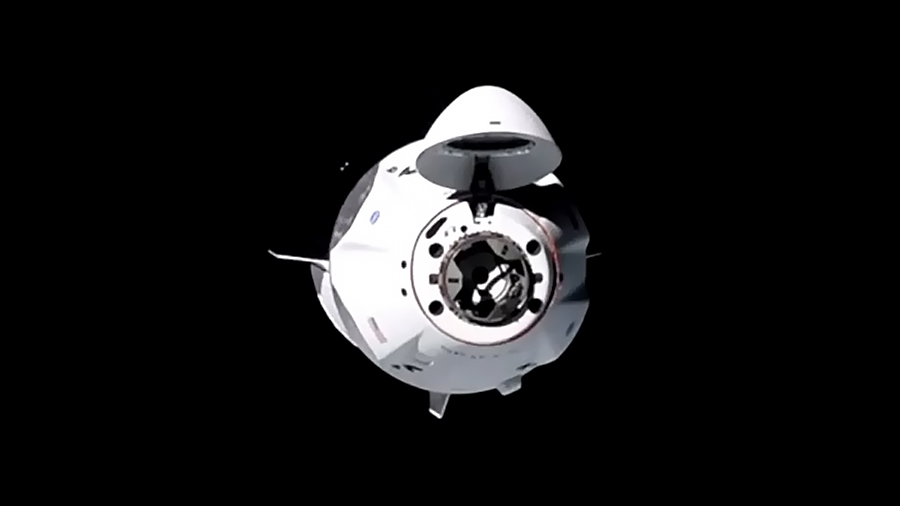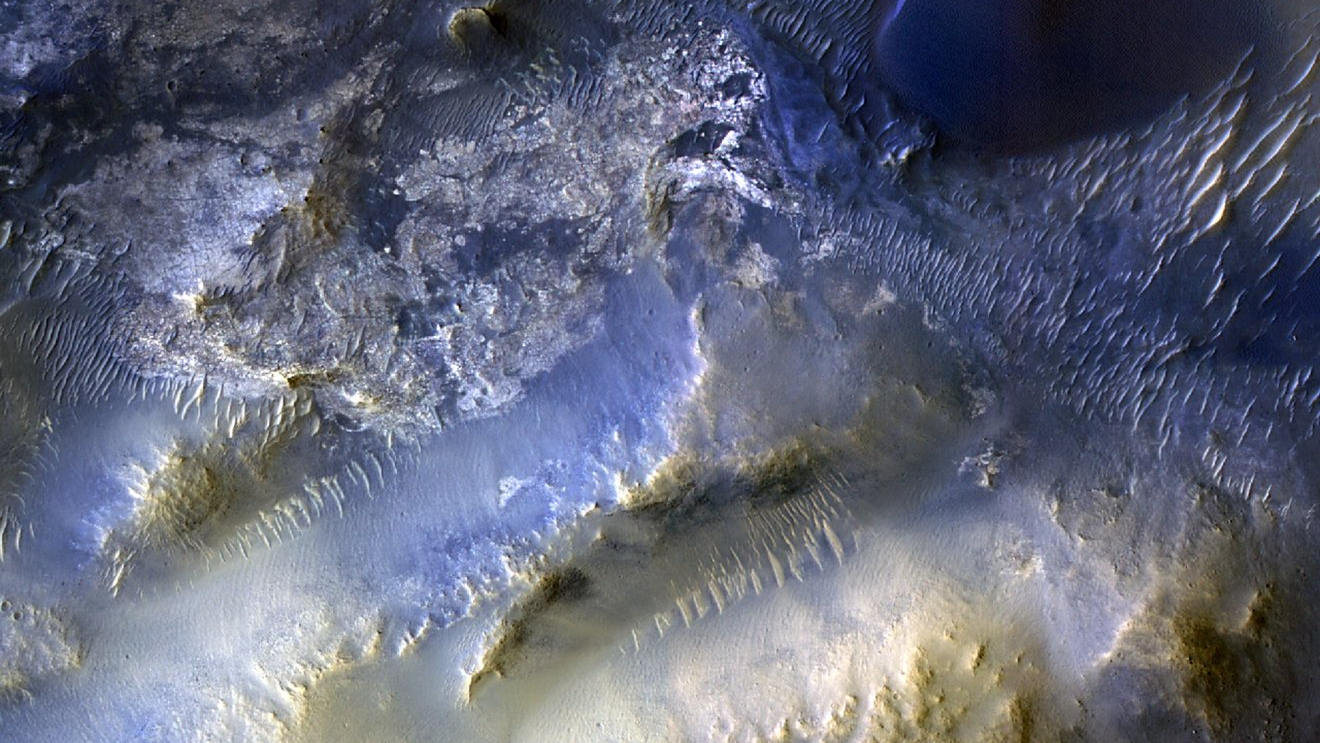SpaceX Crew Dragon capsule docks at space station with its 1st crew of 4
The Crew-1 astronauts have arrived, a first for SpaceX.
SpaceX's Crew Dragon capsule has successfully delivered a crew of four astronauts to the International Space Station for the first time.
After a 27-hour orbital chase, the Crew-1 mission arrived at the space station Monday night (Nov. 16) with four Expedition 64 crewmembers — NASA astronauts Victor Glover, Mike Hopkins and Shannon Walker, and Soichi Noguchi of the Japan Aerospace Exploration Agency, or JAXA. Also on board was a small "Baby Yoda" plush, which serves as a "zero-g indicator" during the ride.
Their Crew Dragon spacecraft, named Resilience, launched on a Falcon 9 rocket from NASA's Kennedy Space Center in Florida Sunday evening (Nov. 15) and docked with the station's Harmony module 27 hours later, at 11:01 p.m. EST (0401 Nov. 17 GMT), kicking off a planned six-month stay at the orbiting laboratory.
"SpaceX, this is Resilience. Excellent job, right down the center," Hopkins told mission control after the docking. "SpaceX and NASA, congratulations. This is a new era of operational flight to the International Space Station from the Florida coast."
Live updates: SpaceX's Crew-1 astronaut launch for NASA
Related: SpaceX's Crew-1 mission in photos
About two hours after docking, the four Crew-1 astronauts floated aboard the space station, kicking off their stay on the orbiting lab.
"We are so excited to be here," Hopkins said during a brief welcome ceremony on the station early Tuesday morning (Nov. 17). "We are humbled and we are excited to be part of this great expedition, and so we are looking forward to the next six months and can't wait to get started."
Breaking space news, the latest updates on rocket launches, skywatching events and more!
The arrival of Resilience marks the first time that a commercial spacecraft has brought astronauts to the International Space Station (ISS) for a long-duration stay. But Crew-1 is not the first mission to use a commercial vehicle to fly astronauts to the ISS; that distinction belongs to SpaceX's Crew Dragon Demo-2 test flight, which brought NASA astronauts Bob Behnken and Doug Hurley to the ISS for a two-month stay earlier this year.
Crew-1 also marks the first time that the ISS has had seven long-duration crewmembers on board, as opposed to the usual six. Three other Expedition 64 crewmembers were already on board the ISS before Resilience arrived: NASA astronaut Kate Rubins and Russian cosmonauts Sergey Ryzhikov and Sergey Kud-Sverchkov, who launched to the space station on Russia's Soyuz MS-17 spacecraft on Oct. 14.
With an extra resident on board, the space station will be short on sleeping quarters for the crew. So, Hopkins, commander of Resilience, is planning to camp out in the Crew Dragon spacecraft while his crewmates sleep inside the space station — at least for now. "We'll continue to evaluate that throughout the mission and make sure that's the right place" for a temporary sleeping station, Hopkins told reporters last week during a prelaunch briefing at Kennedy Space Center.
After NASA retired its space shuttle fleet in 2011, the United States relied entirely on Russia to transport its astronauts to and from the ISS with Russian Soyuz rockets and spacecraft. To reduce its dependence on Russia, NASA contracted SpaceX and Boeing to build commercial vehicles to ferry astronauts to and from the ISS.
SpaceX's Crew Dragon was certified for regular flights to and from the ISS just before Crew-1 launched. Meanwhile, Boeing is still working to successfully complete the first uncrewed test flight of its astronaut taxi, the CST-100 Starliner, after its first attempt failed to reach the correct orbit due to a glitch and had to return to Earth before meeting up with the station. That second test flight is expected to launch sometime in 2021.
SpaceX also holds a NASA contract to fly robotic resupply missions to the ISS, with the cargo version of Dragon. Now that Crew Dragon is certified for regular crewed expeditions, there will be a constant presence of Dragons in orbit.
"For the next 15 months we will fly seven crew and cargo Dragon missions for NASA. That means that, starting with Crew-1, there will be a continuous presence of SpaceX Dragons on orbit," Benji Reed, SpaceX's senior director for human spaceflight, said in a prelaunch news conference. And starting with the cargo mission CRS-21, which is scheduled to launch Dec. 2, "every time we launch a Dragon, there will be two Dragons in space simultaneously for extended periods of time," Reed added.
This story was updated at 1:50 a.m. EST on Nov. 17 to state that the Crew-1 astronauts came aboard the space station about two hours after docking.
Email Hanneke Weitering at hweitering@space.com or follow her on Twitter @hannekescience. Follow us on Twitter @Spacedotcom and on Facebook.

Hanneke Weitering is a multimedia journalist in the Pacific Northwest reporting on the future of aviation at FutureFlight.aero and Aviation International News and was previously the Editor for Spaceflight and Astronomy news here at Space.com. As an editor with over 10 years of experience in science journalism she has previously written for Scholastic Classroom Magazines, MedPage Today and The Joint Institute for Computational Sciences at Oak Ridge National Laboratory. After studying physics at the University of Tennessee in her hometown of Knoxville, she earned her graduate degree in Science, Health and Environmental Reporting (SHERP) from New York University. Hanneke joined the Space.com team in 2016 as a staff writer and producer, covering topics including spaceflight and astronomy. She currently lives in Seattle, home of the Space Needle, with her cat and two snakes. In her spare time, Hanneke enjoys exploring the Rocky Mountains, basking in nature and looking for dark skies to gaze at the cosmos.

